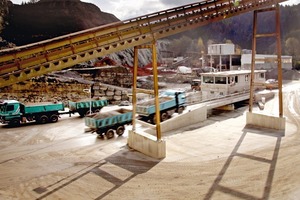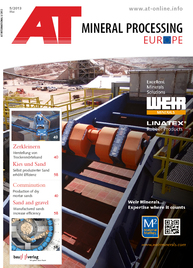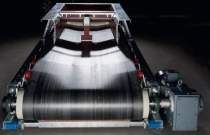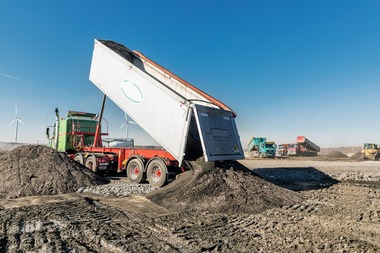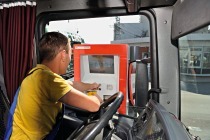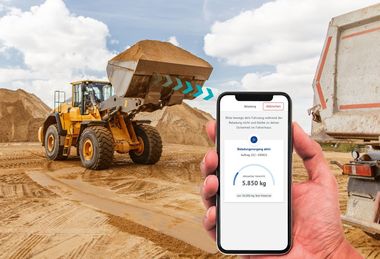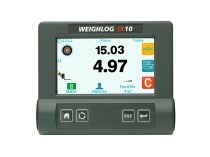Cooperation between WÖHWA Waagenbau and TBSoft
The companies WÖHWA Waagenbau and TBSoft have cooperated since 1 February 2013 in the automation of weighing processes at gravel and ballast plants and complex software applications for sales and distribution companies. WÖHWA and TBSoft have already worked together to realize complex systems at companies such as Baresel, Gfrörer, Basalt AG, Benkert and many more. Customers appreciate the extensive expertise, professional realization, and particularly the uncomplicated and assured long-term servicing of their software products by the two companies.
The complete weighing system, the processing plant and metering and loading systems for ballast, chipping and rock flours were fully automated by WÖHWA (Fig.). All relevant data and measurement results are transferred online to the fully automatic WÖHWA weighing system and the materials management and planning system from TBSoft.
Incoming and outgoing materials are weighed on two WÖHWA truck weighers. The WÖHWA Automation controls the unmanned (night-time operation) and the semi-automatic (daytime operation) weighing and loading process. The master data (customer, construction sites, materials, trucks and schedules) are managed and made available online by the higher level material management and planning software from TBSoft. Accordingly all new master data, entered by sales, accounts or planning, are also instantly available at the weigher at the plant. In TBSoft’s materials management system, tender preparation, sales control, master data management, billing, planning, invoicing, credit assessment, archiving of the delivery notes and invoices, statistics and complex evaluations are performed. The fleet trucks are equipped with telematics and therefore integrated directly and online in planning.
Step 1: The customer orders material from the materials planning office either by telephone or email. In the case of supply orders, the order is entered in the TBSoft planning software and if they come from sales, the orders are assigned accordingly. The planning now automatically determines by “optimization” how the order should run. With the help of clear geographic maps, as well as utilization, vehicle and capacity representations, the planner can optimally assign the trucks to the corresponding transport orders. Simple cycles are considered: plant ➞ construction site ➞ plant or also three-point routes, such as plant ➞ construction site 1 (unloading) ➞ construction site 2 (loading of excavated earth) ➞ plant (offloading). The generated planning data are transferred direct to the weighing computer of the WÖHWA loading system in the plant.
Step 2: The truck drives onto the entrance weigher and the registration number is identified by means of a camera system. With registration number, the WÖHWA system checks whether a transport order has been scheduled for this truck/carrier. If this is the case, the planning data are displayed to the driver on the external monitor. The driver confirms the data and the entry weighing is performed automatically. The loading or unloading point (e.g. for delivery of excavated material) is then displayed to the driver.
Step 3: The driver approaches the corresponding loading point. There the truck is identified and checked based on its registration number by the WÖHWA system. The truck can be loaded fully automatically. Once loading has been completed, the driver is prompted by the display at the appropriate loading point to drive to the exit weigher.
Step 4: When the truck is on the exit weigher, it is identified by a camera and the WÖHWA System prompts the driver to sign off the delivery note on the electronic signature pad. The system generates the delivery note fully automatically. Depending on the loaded material, the appropriate quality labels are printed on the delivery note, and at the same time the delivery note data (incl. signed delivery note as pdf file) are stored with a photo of the truck and transferred to the TBSoft planning and billing system for archiving.
Step 5: The TBSoft planning system immediately reduces the order volume by the loaded amount. The planning data (order and delivery destination) are transferred and visualized directly via the telematics interface on the navigation device of the corresponding truck. This ensures that every driver navigates correctly to his destination. The planner has all trucks in view on his map in the TBSoft planning system. In addition, the planner is informed online via telematics about key statuses, e.g. “Departure from plant”, “Arrival at construction site”, “Waiting to unload”, “Unloading”, and “On return trip”, etc.
Step 6: The individual delivery notes are automatically billed and invoices issued to the customer.
WÖHWA and TBSoft see for the future great potential in the more effective evaluation of production data from the different processing plants direct in materials management, e.g. mass flow recording, energy, maintenance costs recording and much more. This way the users get a much more precise overview of production costs of their different products.

